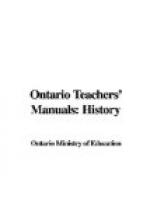It was because of what she had done in this way that she was asked to go to the Crimea to take charge of the hospitals for the English soldiers. When she came there she found things in a terrible condition. The sick and wounded men were crowded in such unhealthy rooms that they had very little chance to get well. She cleaned up the buildings, gave the patients clean beds and clothes, and saw that they had good, well-cooked food to eat. She looked after their comfort, sat beside their beds when they were very ill, and wrote letters for them to their families at home. Because she often walked through the rooms at night, alone, and carrying a little lamp in her hand, to see that everything was all right, she was called “the lady with the lamp.” As she went about, speaking to some, nodding and smiling to others, we can imagine how much the poor soldiers thought of her.
When the war was over, the people of England were so grateful to her that the Government gave her a very large sum of money, $250,000, but she gave it all to build a school where nurses might be trained for their work. Queen Victoria gave her a beautiful jewel to show what she thought of the brave work that Florence Nightingale did.
She lived for many years, doing a great deal to show how to treat people who are ill, and how to keep people well by securing for them “pure air, pure water, cleanliness, and light.” She died August 10, 1910, but the good she did in saving the lives of so many soldiers will always be remembered.
METHOD
It is not intended that this story should be given to the pupils just as it is here. This account is given to indicate what facts may be told to pupils as young even as those in the senior part of Form I, and how the story may be simplified for their understanding. After the story is told, vividly and sympathetically, the reproduction by the class follows in the usual way.
FORM II
THE POSTMASTER
AN INTRODUCTORY LESSON IN CIVICS
This is an introductory lesson in civics, in which the aim is to make the pupils familiar with the duties, qualifications, salary, and importance of the postmaster.
The teacher and class, in imagination, make a visit to the post-office and describe what may be seen therein. A pupil’s letter is prepared, and the teacher, by using an old envelope, shows what is done with the letter till it reaches the person to whom it is addressed, tabulating these points on the black-board: (1) Stamped; (2) Stamp cancelled; (3) Placed in the mail bag; (4) Taken to the railway station; (5) Placed on the train; (6) Received at its destination; (7) Marked to show date on which it was received; (8) Sorted; (9) Delivered. Another used envelope should be shown to the pupils that they may trace, from the impressions stamped upon it, its “sending” and “receiving” offices. From a consideration of these several duties of the postmaster the pupils may be led to see that he should be an honest, careful, courteous, and prompt person.




